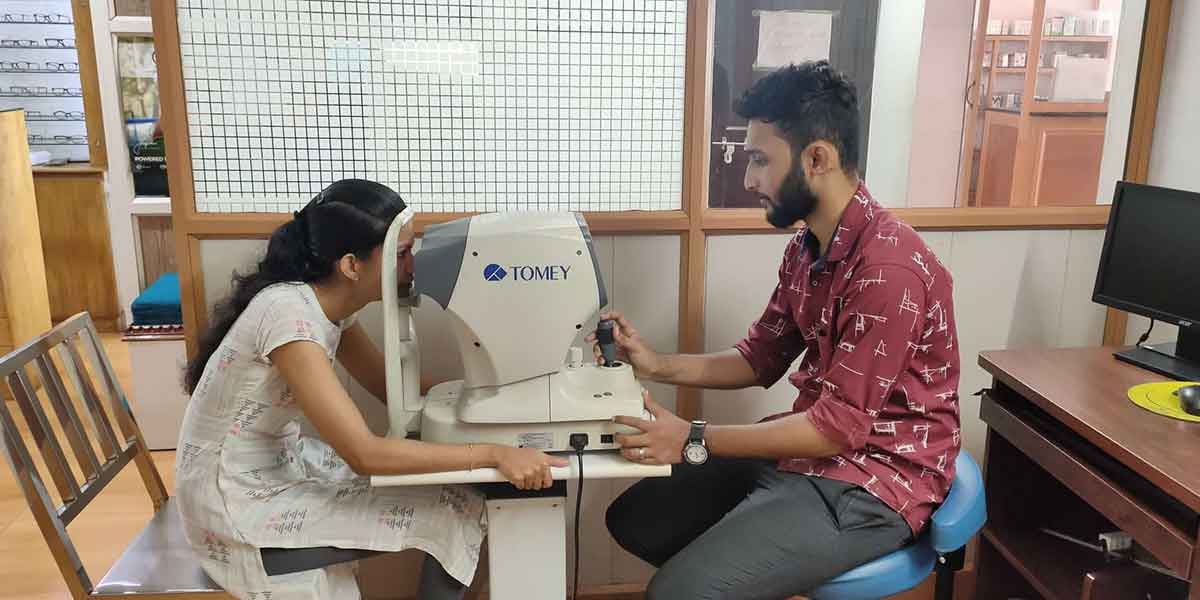An autorefractor is a vital instrument in optometry used to measure how light changes as it enters a person’s eye. This device is crucial for determining the patient’s prescription for glasses or contact lenses. In this comprehensive guide, we explore the functions, significance, advancements, and applications of autorefractors, as well as their impact on optometric practice and career opportunities.
Keywords: autorefractor, optometry, eye measurement, refractive error, eyeglass prescription, optometric instruments, optometrist careers, eye examination.
Understanding the Autorefractor
What is an Autorefractor?
An autorefractor is an ophthalmic device used to measure the refractive error of the eyes automatically. The autorefractor shines light into the eye and measures how it changes as it bounces back off the retina. This process provides an objective measurement of refractive error, which can then be used to prescribe corrective lenses.
They are essential in determining the degree of nearsightedness (myopia), farsightedness (hyperopia), and astigmatism. These devices offer quick and reliable measurements, making them invaluable in both clinical and retail optometry settings.

Historical Development of Autorefractors
The development of this machine began in the mid-20th century, with early models providing basic measurements of refractive error. These devices have evolved significantly, incorporating advanced optics and digital technology to improve accuracy and ease of use.
Modern autorefractors are highly sophisticated, offering detailed measurements and integrated features such as keratometry (measuring the curvature of the cornea). These advancements have made autorefractors an indispensable tool in contemporary optometric practice.
Function and Use of Autorefractors
How an Autorefractor Works
An autorefractor operates by projecting a light beam into the eye and analyzing the reflection off the retina. The device measures the amount of light reflected back and calculates the eye’s refractive error. This process is quick, typically taking just a few seconds per eye.
The patient looks into the autorefractor at a target image, which helps the eye maintain a steady focus. The device then automatically adjusts to measure how light is altered as it travels through the eye, providing an accurate assessment of refractive error.
Steps in Using an Autorefractor
- Patient Preparation: Ensure the patient is comfortably seated and positioned correctly.
- Focusing: Align the autorefractor with the patient’s eye, having them focus on a target image.
- Measurement: The autorefractor projects light into the eye and captures the reflected light to measure refractive error.
- Results Interpretation: The device provides a printout or digital readout of the refractive measurements.
Optometrists use these measurements as a baseline for further subjective refraction tests using a phoropter or trial lenses. The quick and automated nature of autorefractors enhances the efficiency of eye exams.
Types of Autorefractors
Tabletop Autorefractors
Tabletop autorefractors are stationary devices commonly found in optometric offices. These larger units provide highly accurate measurements and often include additional features such as corneal topography. They are ideal for comprehensive eye exams and are a staple in most clinical settings.
Tabletop autorefractors are known for their stability and precision. They are designed to accommodate various patient positions and provide a comfortable testing experience. Their robust construction and advanced features make them suitable for high-volume practices.
Portable Autorefractors
Portable autorefractors are compact, handheld devices that offer flexibility and convenience. These units are particularly useful for mobile clinics, home visits, and screenings in schools or workplaces. Portable autorefractors are designed to provide reliable measurements in a variety of settings.
Despite their smaller size, portable autorefractors deliver accurate and consistent results. They are battery-operated and easy to transport, making them ideal for on-the-go optometry services. These devices expand access to eye care, especially in remote or underserved areas.

Advancements in Autorefractor Technology
Digital and Automated Features
Modern autorefractors incorporate digital and automated features that enhance their functionality. These devices can store and analyze patient data, integrate with electronic health records (EHR) systems, and provide detailed reports. Digital autorefractors improve the accuracy and efficiency of eye exams.
Automation in autorefractors minimizes the need for manual adjustments, reducing the potential for human error. These devices can quickly adapt to different patient needs, providing consistent and reliable measurements. Digital readouts and automated printouts streamline the diagnostic process.
Integration with Diagnostic Tools
Autorefractors are often integrated with other diagnostic tools such as keratometers and corneal topographers. This integration allows for a comprehensive assessment of the patient’s visual health. By combining multiple diagnostic functions, autorefractors provide a more complete picture of the eye’s condition.
The integration of autorefractors with other diagnostic tools enhances the accuracy of refractive measurements. These devices can simultaneously assess refractive error and corneal curvature, providing valuable data for contact lens fitting and refractive surgery planning.
Advanced Imaging Capabilities
Recent advancements in autorefractor technology include enhanced imaging capabilities. Some autorefractors are equipped with high-resolution cameras that capture detailed images of the eye’s structure. These images can be used to diagnose and monitor a range of eye conditions.
High-resolution imaging allows optometrists to detect subtle changes in the eye’s anatomy, leading to earlier diagnosis and treatment of conditions such as keratoconus and cataracts. Advanced imaging capabilities make autorefractors a versatile tool in comprehensive eye care.
Essential Skills for Using an Autorefractor
Technical Proficiency
Operating an autorefractor requires technical expertise and familiarity with its various functions. Optometrists must understand how to align the device, interpret the measurements, and ensure accurate results. Mastery of these technical skills is crucial for performing precise and effective eye exams.
Technical proficiency also involves maintaining and calibrating the autorefractor. Regular maintenance ensures the device operates correctly and provides accurate measurements. Optometrists must be knowledgeable about troubleshooting common issues and performing routine upkeep.
Patient Communication
Effective communication is essential for gathering accurate information from patients. Optometrists must explain the examination process clearly and ensure the patient understands the importance of maintaining a steady focus. Building rapport with patients encourages cooperation and accurate feedback.
Patient communication also involves discussing the results of the autorefractor exam. Optometrists must explain the findings in a way that is easy for patients to understand and discuss the next steps for treatment. Clear communication fosters trust and enhances the patient experience.
Diagnostic Interpretation
Interpreting the results of an autorefractor exam requires a deep understanding of ocular physiology and refractive errors. Optometrists must analyze the measurements and integrate them with other diagnostic data to make informed decisions about treatment. This analytical skill is key to providing high-quality eye care.
Diagnostic interpretation involves comparing the autorefractor results with subjective refraction findings. Optometrists must consider factors such as patient age, eye health, and visual needs when determining the final prescription. Accurate interpretation ensures effective vision correction.
Career Opportunities in Optometry
Private Practice
Many optometrists choose to establish their own private practices, offering personalized eye care services to their communities. Owning a practice allows optometrists to set their schedules, choose their equipment, and build lasting relationships with patients. Private practice can be financially rewarding and professionally fulfilling.
Private practice optometrists provide comprehensive eye exams, diagnose and treat eye conditions, and prescribe corrective lenses. They may also offer specialized services such as contact lens fittings and vision therapy. Building a successful private practice requires business acumen, marketing skills, and a commitment to patient care.
Healthcare Institutions
Optometrists also find opportunities in hospitals, clinics, and specialized eye care centers. Working in a healthcare institution provides access to a wider range of diagnostic tools and collaboration with other healthcare professionals. This environment is ideal for optometrists who enjoy working in multidisciplinary teams.
Healthcare institutions often serve a diverse patient population, providing optometrists with opportunities to diagnose and treat a variety of eye conditions. Optometrists in these settings may also participate in clinical research, contribute to public health initiatives, and educate patients about eye care.
Academia and Research
For those interested in education and research, academic institutions offer careers in teaching and scientific investigation. Optometry schools and universities need experienced practitioners to educate future optometrists. Research opportunities allow optometrists to contribute to advancements in eye care and vision science.
Academic optometrists teach courses, supervise clinical training, and mentor students. They may also conduct research on topics such as new diagnostic technologies, treatments for eye diseases, and the impact of visual health on overall well-being. Academia offers a rewarding career path for optometrists passionate about education and innovation.

Services for Job Seekers in Optometry
Skill Development and Presentation
Our services include training in the latest optometric technologies and best practices, ensuring you stay updated with industry advancements. We offer workshops on effectively presenting your technical expertise to employers. This includes crafting compelling resumes, preparing for technical interviews, and showcasing practical experience with optometry instruments like autorefractors.
Our resume workshops focus on highlighting your skills and experience in a professional manner. Learn how to emphasize your expertise in using autorefractors and other diagnostic tools, making your resume stand out to potential employers. We also provide mock interviews to help you practice discussing your technical abilities confidently.
Networking and Mentorship
We facilitate networking opportunities with industry professionals and mentors. These connections can provide valuable insights into the job market, help you understand employer expectations, and offer guidance on career development. Our mentorship programs pair you with experienced optometrists and industry experts who can provide personalized advice and support.
Networking events and professional conferences are excellent opportunities to meet potential employers and colleagues. Our services help you navigate these events, make meaningful connections, and leverage your network for career advancement. Mentorship provides ongoing support and guidance as you build your career in
Services for Job Seekers in Optometry (continued)
Networking and Mentorship
We facilitate networking opportunities with industry professionals and mentors. These connections can provide valuable insights into the job market, help you understand employer expectations, and offer guidance on career development. Our mentorship programs pair you with experienced optometrists and industry experts who can provide personalized advice and support.
Networking events and professional conferences are excellent opportunities to meet potential employers and colleagues. Our services help you navigate these events, make meaningful connections, and leverage your network for career advancement. Mentorship provides ongoing support and guidance as you build your career in optometry.
Consulting Services for Optometrists and Small Businesses
For newly graduated optometrists, we offer career consulting sessions that include resume reviews, interview coaching, and job search strategies. Our experts can help you identify opportunities that align with your skills in optometry and other areas of eye care. We also provide advice on continuing education and certification programs to enhance your qualifications.
Our career consulting sessions are tailored to your individual needs and goals. Whether you are seeking your first job or looking to advance your career, our consultants provide personalized guidance and support. We help you navigate the job market, prepare for interviews, and develop a career plan that aligns with your aspirations.
For small businesses, we provide consulting services to optimize your practice operations. This includes guidance on selecting and implementing optometric instruments, training staff, and improving patient care workflows. Our consultants can help you develop business strategies, marketing plans, and financial management practices to ensure the success and growth of your optometry practice.
Optimizing practice operations involves streamlining administrative processes, enhancing patient experiences, and maximizing efficiency. Our consultants work with you to identify areas for improvement and implement solutions that drive success. By leveraging our expertise, you can achieve sustainable growth and provide high-quality care to your patients.
To learn more about our services and schedule a consulting session, please visit our website or contact us directly.
Leading Companies in Autorefractor Manufacturing
Essilor Instruments
Essilor Instruments is a major player in the field of optometric equipment, known for its innovative and high-quality autorefractors. Essilor’s devices are designed to provide accurate and efficient measurements, enhancing the diagnostic capabilities of optometrists. The company’s commitment to research and development ensures that their products remain at the forefront of technology.
Essilor Instruments focuses on integrating user-friendly features and advanced technology into their autorefractors, making them accessible and effective for optometric practices of all sizes. Their products are widely used in both clinical and retail settings. For more information, visit Essilor Instruments.
Welch Allyn
Welch Allyn, a division of Hillrom, is renowned for its medical diagnostic equipment, including high-precision autorefractors. Their devices are designed to deliver quick, accurate measurements of refractive error, making them indispensable tools in optometric practices. Welch Allyn’s products are known for their reliability and ease of use.
The company’s autorefractors incorporate advanced optics and digital technology, providing detailed and consistent results. Welch Allyn’s commitment to quality and innovation has made them a trusted name in the field of optometry. For more information, visit Welch Allyn.
Huvitz
Huvitz is a leading manufacturer of diagnostic instruments for optometry and ophthalmology. Known for their high-performance autorefractors, Huvitz provides optometrists with the tools needed to perform accurate and efficient eye exams. Their devices are designed to be user-friendly, offering intuitive interfaces and reliable measurements.
Huvitz’s product line includes autorefractors with integrated keratometry and advanced imaging capabilities. These features enhance the diagnostic process and provide comprehensive data for patient care. Huvitz continues to innovate, ensuring their instruments meet the evolving needs of eye care professionals. For more information, visit Huvitz.
Takagi
Takagi is a respected name in the field of optometric and ophthalmic equipment, known for producing high-quality autorefractors. Their instruments are designed to deliver precise measurements, helping optometrists diagnose and treat refractive errors effectively. Takagi’s commitment to excellence and innovation has established them as a leader in the industry.
Takagi’s autorefractors are equipped with advanced features such as automatic alignment and high-resolution imaging, providing detailed and accurate diagnostic data. These devices are widely used in clinical settings around the world. For more information, visit Takagi.
Shin-Nippon (Rexxam Co., Ltd.)
Shin-Nippon, a division of Rexxam Co., Ltd., is a prominent manufacturer of diagnostic instruments for eye care. Their autorefractors are known for their accuracy, durability, and advanced technology. Shin-Nippon’s devices are designed to provide quick and reliable measurements, enhancing the efficiency of eye exams.
The company’s autorefractors feature user-friendly interfaces and automatic functions, making them easy to operate. Shin-Nippon continues to innovate, offering optometrists cutting-edge tools for comprehensive eye care. For more information, visit Shin-Nippon.
The Importance of Autorefractors in Optometry
Enhancing Diagnostic Accuracy
Autorefractors play a crucial role in ensuring diagnostic accuracy in optometry. By providing precise measurements of refractive errors, these devices help optometrists prescribe the correct lenses for patients. Accurate prescriptions are essential for improving visual acuity and enhancing the overall quality of life for patients.
In addition to determining refractive errors, autorefractors can aid in diagnosing other eye conditions. By thoroughly assessing how light is refracted through the eye, optometrists can detect early signs of conditions such as keratoconus or irregular astigmatism. Early detection and intervention are key to preventing further deterioration of vision.
Improving Patient Experience
Autorefractors contribute significantly to the patient experience during eye exams. Modern autorefractors are designed to be comfortable and easy to use, ensuring that patients can provide accurate feedback. The ability to quickly and smoothly obtain measurements minimizes patient discomfort and streamlines the examination process.
Moreover, autorefractors with advanced features such as digital readouts and automated adjustments enhance the efficiency of eye exams. Patients benefit from faster, more accurate measurements, reducing the overall time spent in the examination chair. Improved patient experience leads to higher satisfaction and better compliance with prescribed treatments.
The Role of Autorefractors in Comprehensive Eye Exams
Assessing Visual Acuity
Visual acuity assessment is a fundamental component of comprehensive eye exams. Autorefractors are instrumental in determining the sharpness and clarity of a patient’s vision. By providing accurate measurements, optometrists can identify the best correction for each eye, ensuring that patients achieve optimal visual acuity.
This process involves capturing precise measurements of refractive errors and using these data points to refine the prescription. Accurate visual acuity assessments are crucial for diagnosing refractive errors and prescribing effective corrective lenses.
Evaluating Binocular Vision
Autorefractors are also used to evaluate binocular vision, which is the ability of both eyes to work together effectively. Binocular vision assessments help diagnose conditions such as strabismus (misalignment of the eyes) and amblyopia (lazy eye). These conditions can affect depth perception and overall visual function.
By using autorefractors with integrated binocular vision testing capabilities, optometrists can measure how well the eyes coordinate and align. Detecting and treating binocular vision problems early is essential for preventing long-term visual impairment and ensuring that patients maintain healthy vision.
The Future of Autorefractor Technology
Digital and Automated Innovations
The future of autorefractor technology lies in digital and automated innovations. Digital autorefractors with automated lens changes and advanced diagnostic capabilities are becoming increasingly prevalent. These devices offer enhanced precision, faster measurements, and improved patient comfort.
Automation in autorefractors minimizes the need for manual adjustments, reducing the potential for human error. These devices can quickly adapt to different patient needs, providing consistent and reliable measurements. Digital readouts and automated printouts streamline the diagnostic process.
Teleoptometry and Remote Exams
Teleoptometry, the practice of conducting eye exams remotely, is an emerging trend that will shape the future of optometry. Portable and digital autorefractors are essential tools for teleoptometry, enabling optometrists to perform accurate refractions and eye exams from a distance.
Teleoptometry expands access to eye care, particularly in underserved or remote areas. By utilizing advanced autorefractor technology, optometrists can deliver high-quality care to patients regardless of their location. This approach enhances the reach and efficiency of optometric services.
Artificial Intelligence Integration
Artificial intelligence (AI) integration is set to revolutionize the field of optometry. AI-powered autorefractors can analyze vast amounts of data to provide highly accurate measurements and predictive insights. These devices can identify patterns and trends that may not be apparent through manual analysis.
AI integration also allows for personalized eye care. By analyzing patient data over time, AI-powered autorefractors can recommend customized treatment plans and monitor the effectiveness of interventions. This level of precision and personalization enhances patient outcomes and advances the field of optometry.
Conclusion
Autorefractors are indispensable tools in the field of optometry, essential for accurate diagnosis and effective treatment of refractive errors. The advancements in autorefractor technology have significantly improved the precision and efficiency of eye exams, benefiting both optometrists and patients. The future of autorefractor technology promises further innovations that will continue to enhance the practice of optometry.
For those pursuing a career in optometry, proficiency in using autorefractors and other diagnostic instruments is crucial. Our services for job seekers and consulting for optometry practices can help you achieve success in this rewarding field.
To learn more about our services and schedule a consulting session, please visit our website or contact us directly.
Conclusion
Autorefractors are indispensable tools in the field of optometry, essential for accurate diagnosis and effective treatment of refractive errors. The advancements in autorefractor technology have significantly improved the precision and efficiency of eye exams, benefiting both optometrists and patients. The future of autorefractor technology promises further innovations that will continue to enhance the practice of optometry.
For those pursuing a career in optometry, proficiency in using autorefractors and other diagnostic instruments is crucial. Our services for job seekers and consulting for optometry practices can help you achieve success in this rewarding field.
To learn more about our services and schedule a consulting session, please visit our website or contact us directly.
For more detailed information, visit the American Academy of Optometry and the National Eye Institute.
Relevant Key Phrases and Keywords: autorefractor, optometry, eye measurement, refractive error, eyeglass prescription, optometric instruments, optometrist careers, eye examination, Essilor Instruments, Welch Allyn, Huvitz, Takagi, Shin-Nippon.

